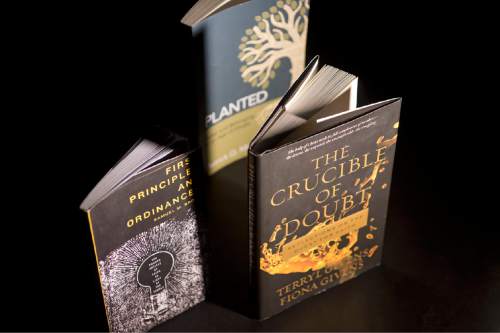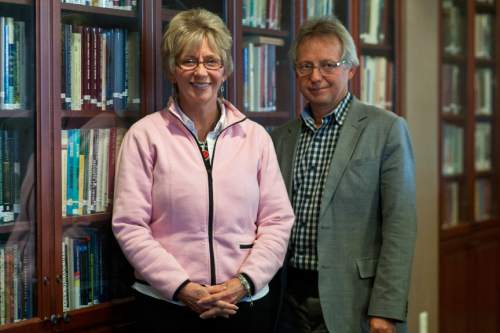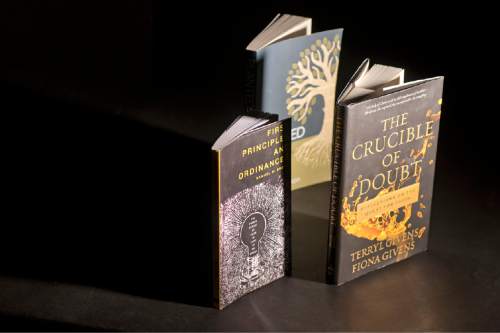This is an archived article that was published on sltrib.com in 2016, and information in the article may be outdated. It is provided only for personal research purposes and may not be reprinted.
Mormonism has had its doubters and dropouts since its founding nearly two centuries ago, but today's crisis of faith among Information Age believers somehow seems new.
Modern. Multifaceted. Unexpected. Unusually troubling. Vast.
It is affecting Latter-day Saints of all types, young and old, lifers and converts, women and men, scholars, students and scientists, stay-at-home parents and careerists. Their numbers appear staggering as many wrestle with questions of prophetic fallibility, historic revisionism, polygamy, the origins of the faith's signature scripture, the Book of Mormon, past racism and violence, women's roles in a male-led hierarchy and where gays fit in the culture and the creed.
Believing intellectuals — including historians Richard and Claudia Bushman and literary experts Terryl and Fiona Givens — have defended Mormonism in correspondence, published pieces and intimate "fireside" conversations. The Neal A. Maxwell Institute for Religious Scholarship at LDS Church-owned Brigham Young University has issued several volumes, exploring the theological strengths of the American-born religion.
The 15 million-member Church of Jesus Christ of Latter-day Saints produced 11 essays, outlining more forthright and nuanced views of Mormon history and doctrine, while the LDS History Museum redid its main exhibit, including context and controversies in its description of the faith's founding events. In recent years, even its typically cautious official publishing arm has produced high-profile books addressed to questioning Mormons.
In late December, Deseret Book came out with another work along this line: "Planted: Belief and Belonging in an Age of Doubt," by Patrick Q. Mason, Howard W. Hunter Chair of Mormon Studies at Claremont Graduate University in Southern California.
Have all these LDS efforts slowed or halted the faith-crisis trajectory, which has catapulted many out of the fold? Or is the exodus just gaining momentum? And, in the long run, will the church emerge weaker or stronger?
—
Awakening • Collin McDonald attended LDS Church services Jan. 31 for the last time.
McDonald's questioning began in 2012, while preparing to teach his Mormon Sunday school class about church founder Joseph Smith's experience with the divine.
Known as the "First Vision," the canonical account describes Smith's encounter with two heavenly beings, God the Father and Jesus Christ, during which the 14-year-old Smith was told not to join any church and that he would be the instrument through which the uncorrupted gospel would be returned to the Earth.
That version, published decades later, doesn't match the details Smith had offered on earlier occasions, including one in which he said he saw only "the Lord." The discrepancies are described and explained in the faith's own essay on the topic. The various accounts are merged in the revamped history museum.
McDonald, a lifelong Mormon in South Jordan, had only ever heard the official one.
Thus began his quest to grasp the facts — and not just faith-promoting interpretations — about Mormon history. McDonald thought he could cope with the issues of the past. He then ran into a distressing development in the present: LDS leaders announced a policy in November labeling same-sex Mormon couples apostates and denying their children baptism until they turn 18.
Since then, McDonald, whose sister is gay, has felt "tortured and suffocated," he says. "I have now chosen to step away."
McDonald was among the more than 1,700 Mormons and former believers who responded to The Salt Lake Tribune's outreach to those grappling with a faith crisis. They hailed from across the nation and other countries. Nearly a third have left the LDS Church, many citing a blend of triggers from historical anomalies to contemporary concerns. Even more no longer are practicing Mormons. Dozens cited Jeremy Runnells' 2013 "Letter to a CES [Church Educational System] Director," which outlined numerous questions about Mormonism's past and present. Runnells says he has been told by his local lay leaders in American Fork that he may face a church disciplinary council next month.
For McDonald, his parting with the faith may not be final.
"I don't feel like I'm divorced from the church or if this is just a separation," he says. "I don't know if taking my name off the [church's membership] rolls is going to be in the cards for me. If a pattern of retrenchment continues on social issues, that will make it more difficult."
His wife and two children will continue attending services, McDonald says, and several members of his congregation, including his LDS bishop, have reached out to him in love.
"Mormonism is still my tribe, still my people, I still care for them individually and collectively. I don't look to replace it, either."
—
When the righteous are wrong • In his new book, Mason describes two kinds of Mormons who are leaving the church these days: the "switched off" and the "squeezed out."
The first group includes Latter-day Saints "who, after a life of service in the church, encounter troubling information online or somewhere else, usually regarding our history or doctrine," he writes. "This new knowledge does not square with what they had previously learned … sometimes by way of direct contradiction."
The second group contains members who feel "like they just don't fit in at church," Mason writes, often based more in cultural expectations — like white shirts for men and dresses for women — than Mormon teachings. Some feel "alienated by things like the dominant political conservatism of church members," he adds, " … or heartfelt questions about whether girls and women have all the opportunities for spiritual growth and recognition in the church that boys and men do."
Many of the concerns for both groups center on a belief that God would not let Mormon officials make any big mistakes.
Believers are more comfortable talking about leader fallibility "the more distant the prophets are," Mason says in an interview. "On Old Testament prophets, Joseph Smith and Brigham Young, we are getting better."
It's harder, though, with modern-day Mormon authorities.
"What I see in the unwillingness to talk about the flaws of our leaders is an attempt to hold onto our faith," he says. "It's hard to be a person of faith in the 21st century. The option not to believe is increasingly easy."
For Mason, though, it is vital to acknowledge human frailty among church leaders. Too many members fall for the simplistic reasoning that if the prophet's wrong about one thing, he says, "it's all a house of cards."
Mason's approach liberates believers like him from that "house of cards." One of the most "empowering aspects of Mormon theology," he says, is understanding God works through imperfect people and that human mistakes don't topple a God-inspired institution.
Dieter F. Uchtdorf, second counselor in the governing LDS First Presidency, confronted the fallibility question head-on in a 2013 General Conference sermon.
"To be perfectly frank," he said, "there have been times when members or leaders in the church have simply made mistakes."
In his chapter, "When Church Is Hard," Mason moves beyond the past to deal with current discomforts.
"If Zion is the ideal society, then it's immediately apparent that our local wards, and therefore the church as a whole, fall woefully short," Mason writes. " … Staying in the boat and holding on is hard, often straining us to our very limits."
There are plenty of "institutional and structural questions that need to be addressed," Mason says, but he challenges readers to consider how they can "exhibit Christian virtues."
—
Balancing act • Kevin Leggat, a 39-year-old Mormon accountant in South Jordan, has been dealing with doubts for 20 years.
It started in the early 1990s, when Leggat was a young teen and his father, then a Mormon bishop, read Fawn Brodie's Joseph Smith biography, "No Man Knows My History."
The skeptical take shattered the senior Leggat's faith, but he had no one to turn to for help. Other LDS leaders shrugged off his questions, urging him not to read "anti-Mormon books."
"He had zero resources," Leggat says. "The whole shelf [of faith questions] came tumbling down."
Leggat's dad got involved with others who had left Mormonism, and his parents divorced over it — though they remarried two years later and became a "mixed-faith" couple.
On his two-year Mormon mission to Vienna, Kevin Leggat had occasion to talk with a Christian pastor about the Book of Mormon.
"I thought there was all this secret evidence in South America supporting the scripture's historicity," he says, "Then the pastor pulled out some FARMS [Foundation for Ancient Research and Mormon Studies] documents, saying we cannot rely on any archaeological evidence."
It shook him, he says. "I came off my mission with a little seed of critical thinking."
Still, the son harbored fantasies of reconverting his father, Leggat says. "That didn't happen. Instead, we had so many great conversations from then on."
The younger Leggat explored his doubts step by step, tossing out notions he thought were "set in stone," while maintaining belief in more general principles.
In the past five years, Leggat says, books such as Mason's and Adam Miller's "Letters to a Young Mormon" have helped him stick in the church, seeing its good and its "underbelly" at the same time.
Of his nearly 30 closest LDS friends from high school, Leggat says, only a handful remain in the faith.
"It is a really big turning point in the church right now," he says. "When you go to your bishop with white-knuckle questions and he cannot even address them at all, you just feel lost, like it's all a sham, so you leave."
The church is shedding "so many great potential leaders," he says, "who can think critically and can reason well and have some degree of faith. They are some of the ones the church needs the most."
Leaders need to stop talking about questioners as being less faithful, Leggat says. They are just trying to figure it out and should be taken seriously.
"If our faith in the gospel is a fire," he wonders, "do we view doubt as water or fuel?"
—
Scholars to the rescue • Early in 2013, Terryl Givens read his piece, "Letter to a Doubter," to a Mormon group in Palo Alto, Calif.
"The response was so overwhelming," he says, that he knew there was a "vital need."
So Givens, a professor of literature and religion at the University of Richmond, and his wife, Fiona, a retired high school French teacher, wrote "The Crucible of Doubt: Reflections on the Quest of Faith" for Deseret Book.
It is part of the church's wide-ranging strategy to "inoculate" Mormons "against sudden surprises in the historical record," he says. "But some people die of the inoculation. You do have a number of Latter-day Saints being introduced to materials disconcerting enough that they flee the church."
Givens believes there has been an "undeniable sea change in the church's desire to be transparent in its history."
It has come with a cost, though. Even the church's own essays, meant to address the thornier aspects of LDS history and theology, have caused some members to ask questions they never would have had otherwise.
Givens is confident, however, that this new era of openness will lead to "a much healthier and robust membership, grounded in real history and doctrine," he says. "It represents a shift in Mormon cultural consciousness."
For her part, Fiona Givens says women often experience their faith crises differently. They want to know more about "the divine feminine, priesthood authority and their positions in the church."
When the two speak to Mormon groups, she says, "I always get questions about polygamy, heavenly mother and priesthood."
Part of the solution to faith dilemmas, the couple believe, is to present the "beauty, power and coherence [of Mormonism] that is without parallel in the Christian universe."
They launched this approach in 2012 with their book "The God Who Weeps: How Mormonism Makes Sense of Life." They currently are tackling their third volume in the Deseret Book series, titled "The God Who Heals."
Miller's "Letter to a Young Mormon" takes a similarly broad approach.
The author aimed to explore "what it means to be — as a Mormon — free, ambitious, repentant, faithful, informed, prayerful, self-less, hungry, chaste and sealed." He wanted to present, he says, "the real beauty and real costs of trying to live a Mormon life."
—
Who's left out? • Gina Colvin, a Mormon academic in New Zealand, sees these authors speaking mostly to an "informal general authority class of white American Mormon males."
Their focus is on Mormonism's American history, she says, but her homeland wrangles with an altogether different LDS past.
The faith "was and continues to be a brown church that was initially embraced because of its theological flexibility that paid attention to Maori traditional practices and belief systems," Colvin notes in an email.
"There was also a social-justice bent to it that celebrated Maori language and culture and aspirations where other faith traditions recoiled. It was not until the 1970s, during the Maori renaissance, that the church stepped back ... and tried to shape its local practices to fit white sensibilities."
The Utah-based denomination simply "needs to un-Americanize," Colvin says, and "until that can be addressed in faith-crisis writing … it won't touch the structural and governance issues that need addressing so that all people, everywhere, can be blessed in their Mormon faith lives."
The wave of books for doubters also doesn't speak to the concerns of American members of color, says Mica McGriggs, a doctoral student in psychology at BYU.
These Mormons have lived in the shadow of the church's former ban on black men and boys holding its all-male priesthood and women and girls from entering its temples.
The prohibition ended in June 1978, but it wasn't until 2013 that the church essay explained the policy was rooted more in cultural racism than divine revelation.
"Black Mormons don't have the luxury of believing our leaders are perfect," McGriggs says. "We know they make mistakes."
Members of color experience "a constant dull pain of inequality and inferiority," she says. "It isn't the sharp pain of falling from the privilege of certainty when a white member learns a painful truth about this church, but we too know pain. We have been living with this constant pain of being on the margins since the inception of this tradition and we have learned to survive and even thrive."
Instead of trying to rid Latter-day Saints of the discomfort or pain of a faith crisis, she asks, why not learn from it?
"It could be," McGriggs says, "an exercise in empathy for what members of color inevitably experience."
It's not a bad place to be, she says. "It's where God lives."
pstack@sltrib.com Twitter: @religiongal







